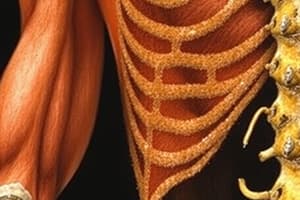Podcast
Questions and Answers
What is the primary role of myofibrils in muscle tissue?
What is the primary role of myofibrils in muscle tissue?
- To provide energy for muscle contractions
- To extend the length of muscle fibers
- To control the movement and contraction of muscles (correct)
- To transport oxygen within the muscle
Which statement best describes the composition of sarcomeres?
Which statement best describes the composition of sarcomeres?
- They consist of actin and myosin filaments organized end to end (correct)
- They contain only myosin filaments arranged in bundles
- They are composed primarily of connective tissue
- They are made of muscle fibers connected by nerves
What is the significance of the thickness of myosin compared to actin?
What is the significance of the thickness of myosin compared to actin?
- It allows myosin to conduct electrical impulses
- It helps in the repair of muscle tissue
- It facilitates stronger muscle contractions (correct)
- It prevents injury during muscle stretching
What is the maximum amount a muscle can be stretched without tearing?
What is the maximum amount a muscle can be stretched without tearing?
Which muscle function is correctly defined as 'contractility'?
Which muscle function is correctly defined as 'contractility'?
What does the term extensibility refer to in muscle physiology?
What does the term extensibility refer to in muscle physiology?
How does elasticity contribute to muscle function?
How does elasticity contribute to muscle function?
Which of the following correctly identifies a primary function of muscle tissue?
Which of the following correctly identifies a primary function of muscle tissue?
What is one of the main functions of a lever system in relation to muscle activity?
What is one of the main functions of a lever system in relation to muscle activity?
What defines muscle tone in skeletal muscles?
What defines muscle tone in skeletal muscles?
What is an example of a prime mover in muscle function?
What is an example of a prime mover in muscle function?
Flashcards are hidden until you start studying
Study Notes
Muscle Overview
- Muscle comprises 40% of an individual's total body weight.
- Defined as fibrous tissue capable of contractions that produce movement.
Myofibrils
- Myofibrils are the contractile threads in muscles, stretching entirely from one end of a muscle fiber to the other.
- Composed of two key filaments: Actin (thinner) and Myosin (thicker).
- Organized into units known as sarcomeres, which link end to end to form myofibrils.
Muscle Properties
- Sarcomeres are recognized as the basic structural units of a muscle.
- Flexibility of muscle allows for stretching up to three times without injury.
- Normal human body temperature ranges from 36°C to 37°C.
- Contractility refers to a muscle's ability to shorten forcefully.
- Extensibility is the ability of a muscle to respond to stimuli from motor neurons.
- Elasticity allows muscle fibers to stretch and return to their original length.
Muscle Functions
- Muscles serve various functions, including:
- Facilitating movement.
- Maintaining posture.
- Stabilizing joints.
- Generating heat.
- Storing substances (e.g., glucose).
Lever Systems
- Lever systems coordinate the actions of bones and muscles to enable movement.
- Primary functions include generating muscular effort and enhancing movement speed.
Muscle Tone
- Muscle tone refers to the state of partial contraction of muscles, maintaining readiness for action.
Muscle Groups
- Three main types of muscle tissues:
- Striated (Skeletal) muscle.
- Non-striated (Smooth or Visceral) muscle.
- Cardiac muscle.
Sarcomeres
- Sarcomeres are highly organized structures containing actin and myosin, key for muscle contraction and function.
Studying That Suits You
Use AI to generate personalized quizzes and flashcards to suit your learning preferences.




